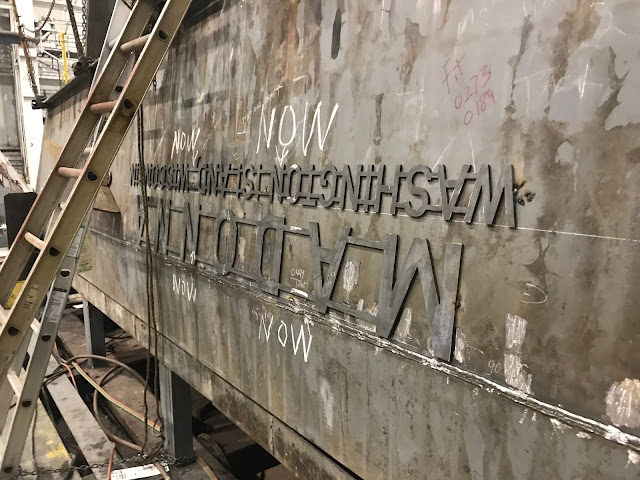Progress continues on the Madonna construction, with special emphasis on the stern section that remains in Bldg. 311 inside the Fincantieri Bay Shipbuilding yard.
Rich Ellefson reported in by phone this Saturday morning to say that weld testing for pinholes continued into the weekend on the stern section. He was standing by to witness completion of this task before coming home. Occasionally a pinhole is discovered that must then be drilled or cleaned, and then welded again to ensure watertight integrity. The test is anything but dramatic in that it consists of visual inspection by a U. S. Coast Guard inspector of many hundreds of feet of weld, but every so often a bubble in the soapy liquid gives clue to a pinhole similar to searching for a leak in a car tire). When a leak is discovered, the welder standing by must clean the surface and lay another pass. It is an essential step in the process of obtaining Coast Guard certification. The worst might be discovering an annoying pinhole leak months later, necessitating grinding of paint coatings before correcting the problem. It could also, if serious enough, require a dry docking to correct.
 |
| Coast Guard Marine Inspector Jim Condra observes inch-by-inch the integrity of shell plating welds. |
One complication in that maneuver may be the projecting of the now vulnerable stern tubes (propeller shaft enclosures), and protrusions that will become supports for the rudder stocks.
A view at the underside of the hull directly outboard from the engine room space shows an inset, rectangular box on either side of the keel. Each pocket will hold a keel cooler, a radiator-like grid manufactured by Fernstrum of Menominee, Michigan. The grid tubes are made of copper/nickel and will provide closed loops for engine cooling liquid on the hull's underside. The material's softness also makes them quite vulnerable to deadheads (errant, waterlogged timbers) and also heavy pieces of ice. For that reason, subway grids will bolt over each cooler, and heavy steel angles will line either side of the coolers to offer further ice protection.
 |
| Gridcoolers pocket with protective angle. |
 |
| Basis for the skeg that will support outer end of each propeller shaft. |
Because of potential for damage to the stern tubes during turnover, should they strike the ground unintentionally, the flipping of the stern section will be a crucial evolution. According to Rich, there might be shipyard preference for an end-for-end rotation, rather than side-to-side rollover, in order to offer less risk should the lift go awry. The location and welding of each stern tube is so critical for shaft alignment that welding involves two opposing workers welding simultaneously on the heavy pieces of steel. Such care is intended to avoid the distortion of stern tube alignment.
Another delicate lift event might be that of the main deck pedestal, a rather lightly constructed "box" that could be a bit "flimsy" when lifted for setting. Temporary stiffeners will be installed as spreaders to maintain the box-like shape until set on deck in its intended position. This lift will occur after turnover and after the joining of the two hull sections.
 |
| View from bow looking aft at the relative positions of the prefabricated pedestal and starboard side curtain. |
These arrived by truck from FABICK CAT in Green Bay.
- Dick Purinton

















